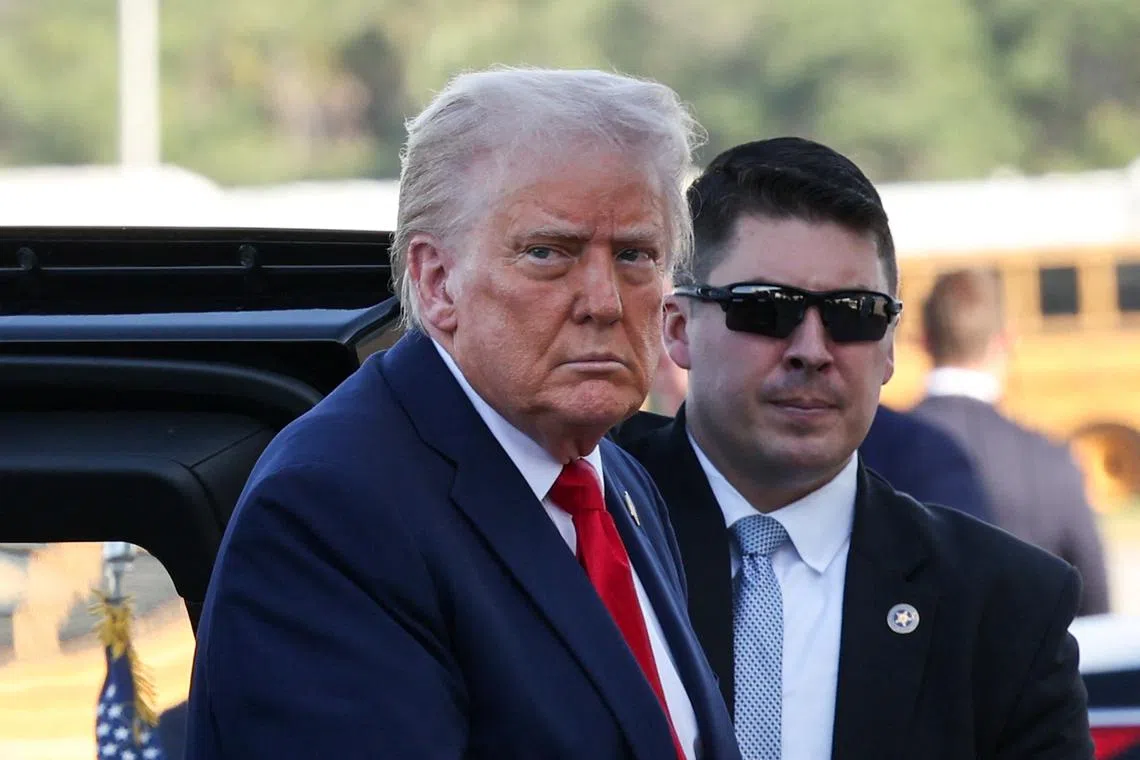Clock ticks on Trump’s reciprocal tariffs as countries seek reprieve
Sign up now: Get ST's newsletters delivered to your inbox

US President Donald Trump has threatened to unleash a wide range of tariffs against countries running persistent trade imbalances.
PHOTO: REUTERS
Follow topic:
WASHINGTON - The clock is ticking down to Mr Donald Trump’s “Liberation Day”, when the US President has threatened to unleash a wide range of tariffs against countries running persistent trade imbalances with the United States.
The move – which comes as Mr Trump has been making unprecedented use of presidential powers – is driven by his insistence that the world’s biggest economy has been “ripped off by every country in the world” and his conviction that reciprocal tariffs are needed to restore parity.
But critics warn that the strategy risks a global trade war, provoking further retaliation by major trading partners like China, Canada and the European Union.
The size of the levies to be announced on April 2 will vary from country to country – depending on the duties they impose on American goods through import tariffs and other factors like value-added taxes.
But the precise plans remain murky.
“Expect the unexpected,” said Mr Ryan Sweet, chief US economist at Oxford Economics.
He expects the Trump administration to “take aim at some of the largest offenders”.
But what matters ultimately is how broad-based the tariffs are and whether the tool is merely a negotiating tactic or part of a regime shift, he said.
Mr Trump on March 31 dashed hopes he might scale back on his threatened tariffs, saying they would include “all countries”.
“You’d start with all countries, so let’s see what happens,” the president told reporters onboard Air Force One.
“We’ve been talking about all countries, not a cutoff,” he said, insisting however that his tariffs would be “far more generous” than those levied against the United States.
US trade partners have been rushing to minimise their exposure ahead of Mr Trump’s deadline, with reports suggesting India might lower some duties.
Besides the reciprocal country tariffs, Mr Trump could also unveil additional sector-specific levies on the likes of pharmaceuticals and semiconductors.
These would come on top of new auto levies due to take effect on April 3.
Already, China and Canada have imposed counter-tariffs on American goods in response to Mr Trump’s earlier actions, while the EU unveiled its own measures, due to start in mid-April.
Canadian Prime Minister Mark Carney told Mr Trump his government would impose retaliatory tariffs
Dirty 15
Before Mr Trump’s comments on March 31, the upcoming salvo is expected to target the 15 per cent of partners that have persistent trade imbalances with his country, a group that US Treasury Secretary Scott Bessent called a “Dirty 15”.
The administration has not released a list of these countries.
But the US has its biggest goods deficits with parties including China, the EU, Mexico, Vietnam, Taiwan, Japan, South Korea, Canada and India.
With countries seeking compromise, it is “entirely possible” for fresh tariffs to be swiftly reduced or put on hold, said Ms Greta Peisch, partner at law firm Wiley Rein.
In February, she noted, steep levies on Mexican and Canadian imports were paused for a month as the North American neighbours furthered negotiations.
“There are many different scenarios: delays while talks continue, potential reductions or tariffs being put in place immediately,” said Ms Peisch, a former official at the US Trade Representative’s office.
Mr Trump has said the April 2 tariffs
Dark cloud
But Mr Sweet of Oxford Economics warned that a “dark cloud of uncertainty” hangs over the economy.
Some domestic steel manufacturers and union leaders have welcomed Mr Trump’s recent tariff hikes on metals and autos.
But while his proposals are meant to revitalise American industry, they have alarmed many other industries.
The American Automotive Policy Council, which represents carmakers Ford, General Motors and Stellantis, cited a report on March 28 by economist Arthur Laffer, which noted that 25 per cent auto tariffs stand to raise US vehicle costs and disrupt supply chains.
While stressing its commitment to Mr Trump’s economic vision, the council urged for “a fair and predictable trade environment”.
In a letter on March 27, the International Fresh Produce Association cautioned that proposed US tariffs and other countries’ retaliation threaten the stability of farmers and businesses.
And the National Retail Federation warned in February that reciprocal tariffs could prove “extremely disruptive”, warning of higher costs to households and an erosion of their spending power.
More broadly, companies tend to hold off on investments when rules are unclear and this could weigh on hiring, Mr Sweet said.
Economists also warn that sweeping tariffs could cause a spike in inflation if companies fail to absorb additional costs, passing them on to consumers.
When it comes to the legal authorities, Ms Peisch told AFP that Mr Trump could invoke emergency economic powers again to impose reciprocal tariffs.
He could also tap Section 301 of the Trade Act to start country-by-country investigations, the same authority he used to target China in his first presidency. AFP

